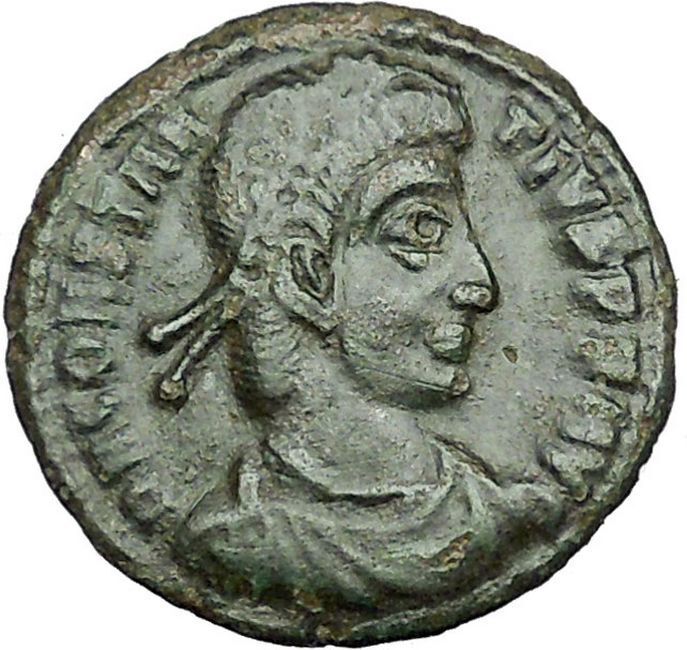|
Tetricus I – Gallic Roman Emperor: 271-274 A.D.
Bronze Antoninianus 18mm (2.78 grams) Struck 273 – 274 A.D.
Reference: RIC 80. Elmer 789. Cohen 57.
IMP TETRICVS P F AVG, radiate and cuirassed bust right
HILARITAS AVGG, Hilaritas standing left, holding long branch and cornucopia.
Hilaritas was the goddess of rejoicing and good humor.
You are bidding on the exact item pictured, provided with a Certificate of Authenticity and Lifetime Guarantee of Authenticity.
Gaius Pius Esuvius Tetricus was Emperor of the Gallic Empire (Imperium Galliarum), reigning 271-274, succeeding the murdered Victorinus and ending with his surrender on the battlefield to the Roman emperor Aurelian. Tetricus, who ruled with his son, Tetricus II, was the last of the Gallic emperors.
Tetricus was a senator born to a noble family of Gallic extraction. He was appointed to the administrative position of praeses provinciae (provincial governor) of Gallia Aquitania in 270, a position he still held when the murder of Victorinus was announced in early 271.
Victorinus’ mother, Victoria, located at Colonia Claudia Ara Agrippinensium, managed to keep control of the political situation after her son’s death; through her influence (and a large amount of money), she bribed the army to declare the absent Tetricus emperor. Tetricus accepted the army’s nomination and took the purple at Burdigala in Gaul.
Moving from Burdigala, he was on his way to Augusta Treverorum (Trier) when Tetricus was forced to repel Germanic tribes that took advantage of the confusion following the death of Victorinus to invade Gaul. By the end of 271 Tetricus had made Augusta Treverorum, near the vital Rhine border, his capital, and had celebrated a Victoria Germanica, but was again called out in 272 to deal with a fresh incursion that reached the River Loire. However, continued invasions across the Rhine and along the coasts forced Tetricus to abandon the frontier forts and withdraw the troops to defend the interior of Gaul.
Regardless of his difficulties with the Germanic invasions, Tetricus was recognised as emperor throughout Britain and most of Gaul apart from Narbonensis, where Placidianus had reclaimed some territory under Claudius II Gothicus. Although Tetricus made no move to expand his territorial reach, he did invest time and resources reclaiming some provinces that had been reconquered by the central empire, such as south-eastern Aquitania and the western parts of Narbonensis. Nevertheless, his regime was destabilised by attempts of certain areas to declare their allegiance to the Roman emperor Aurelian, such as the city of Argentoratum in 272.
It was to shore up his internal support that Tetricus eventually appointed his son, Tetricus II, as Caesar sometime in 273, after celebrating his second consulship on 1 January 273. It did little to stem his faltering regime as in late 273 or early 274, Faustinus, provincial governor of Gallia Belgica, rebelled against him in Augusta Treverorum. To add to his woes, by the middle of 273, the emperor Aurelian set out to reconquer the western provinces of the Roman empire, following his victories in the east. Preparing for his advance, Tetricus and his son celebrated their joint consulship on 1 January 274 before marching southward from his capital to meet Aurelian, who was advancing into northern Gaul. The decisive battle took place near Châlons-sur-Marne, in late February 274: Tetricus’ army was cut to pieces in an event remembered as the Catalaunian catastrophe. By March 274, both Tetricus and his son had surrendered to Aurelian. Later imperial propaganda declared that Tetricus had agreed to surrender to Aurelian in exchange for his life, but the price was to be his betrayal of his army prior to the battle, which in the event continued regardless. It was claimed that Tetricus quoted Virgil in his letter to Aurelian: “eripe me his, invicte, malis” (“rescue me, o undefeated one, from these troubles”).
According to literary sources, after being displayed as trophies at Aurelian’s triumph in Rome, the lives of Tetricus and his son were spared by Aurelian, and Tetricus was even given the title of corrector Lucaniae et Bruttiorum, that is governor of a southern region of Italia. Tetricus died at an unknown date in Italy; he is listed as one of Rome’s Thirty Tyrants in the Historia Augusta.
|










